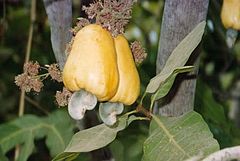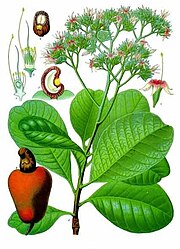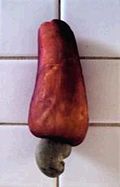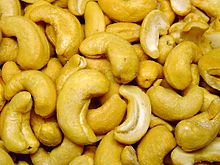Cashew: Difference between revisions
m Reverted edits by 66.67.111.151 to last version by 189.90.16.72 (HG) |
No edit summary |
||
| Line 136: | Line 136: | ||
[[Category:Medicinal plants]] |
[[Category:Medicinal plants]] |
||
[[Category:Tropical agriculture]] |
[[Category:Tropical agriculture]] |
||
[[Category:Flora of Angola]] |
|||
[[Category:Fruits of Angola]] |
|||
[[ar:كاجو]] |
[[ar:كاجو]] |
||
Revision as of 16:47, 4 September 2008
| Cashew | |
|---|---|

| |
| Cashews ready for harvest in Guinea-Bissau | |
| Scientific classification | |
| Kingdom: | |
| Division: | |
| Class: | |
| Order: | |
| Family: | |
| Genus: | |
| Species: | A. occidentale
|
| Binomial name | |
| Anacardium occidentale | |
The cashew (Anacardium occidentale; syn. Anacardium curatellifolium A.St.-Hil.) is a tree in the flowering plant family Anacardiaceae. The plant is native to northeastern Brazil. Its English name derives from the Portuguese name for the fruit of the cashew tree, caju, which in turn derives from the indigenous Tupi name, acajú. It is now widely grown in tropical climates for its cashew "nuts" (see below) and cashew apples.
Habitat and growth


It is a small evergreen tree growing to 10-12m (~32 ft) tall, with a short, often irregularly-shaped trunk. The leaves are spirally arranged, leathery textured, elliptic to obovate, 4 to 22 cm long and 2 to 15 cm broad, with a smooth margin. The flowers are produced in a panicle or corymb up to 26 cm long, each flower small, pale green at first then turning reddish, with five slender, acute petals 7 to 15 mm long.
What appears to be the fruit of the cashew tree is an oval or pear-shaped accessory fruit or false fruit that develops from the receptacle of the cashew flower. Called the cashew apple, better known in Central America as "marañón", it ripens into a yellow and/or red structure about 5–11 cm long. It is edible, and has a strong "sweet" smell and a sweet taste. The pulp of the cashew apple is very juicy, but the skin is fragile, making it unsuitable for transport. It is often used as a flavor in agua fresca.
The true fruit of the cashew tree is a kidney or boxing-glove shaped drupe that grows at the end of the pseudofruit. Actually, the drupe develops first on the tree, and then the peduncle expands into the pseudofruit. Within the true fruit is a single seed, the cashew nut. Although a nut in the culinary sense, in the botanical sense the fruit of the cashew is a seed. The seed is surrounded by a double shell containing a dermatogenic phenolic resin, urushiol, a potent skin irritant toxin also found in the related poison ivy. Some people are allergic to cashew nuts, but cashews are a less frequent allergen than nuts or peanuts.
Etymology
Other names include: cajueiro, cashu, casho, acajuiba, caju, acajou, acaju, acajaiba, alcayoiba, anacarde, anacardier, anacardo, Andi parippu (in Malayalam), cacajuil, cajou, gajus, godambi (in Kannada), jeedi pappu (in Telugu), jocote maranon, maranon, merey, Mundhiri paruppu (Tamil), noix d’acajou, pomme cajou, pomme, jambu, jambu golok, jambu mete, jambu monyet, jambu terong, kasoy (Tagalog), and hạt điều in Vietnamese language. In the Antilles in Puerto Rico, it is known as pajuil, Indian nut in Slovenia, and in the Dominican Republic as the cajuil. The pseudofruit is the main part used as raw fruit.
Cashew industry
Originally spread from Brazil by the Portuguese, the cashew tree is now cultivated in all regions with a sufficiently warm and humid climate. It is produced in around 32 countries of the world. The world production figures of cashew crop, published by the UN's Food and Agriculture Organization (FAO), was around 3.1 million tons per annum. The major raw cashew producing countries with their production figures in 2006 (as per the FAO) are Vietnam (941,600 tons), Nigeria (636,000 tons), India called Kaju (573,000 tons), Brazil (236,140 tons) and Indonesia (122,000 tons).
World’s total area under the cultivation of cashew is around 33,900 km². India ranks first in area utilized for cashew production, though its yields are relatively low. The world’s average yield is 817 pounds per acre (916 kg/hectare) of land
Collectively, Vietnam, Nigeria, India and Brazil account for more than 90% of all cashew kernel exports. Some varieties of cashews come from Kollam or Quilon in Kerala, Southern India which alone produces 4,000 tons of cashews per annum. The major trading centers of cashew in India are Palasa, Kollam or Quilon Mangalore and Kochi.
| Top Ten Cashew Producers — 2005 | ||||
|---|---|---|---|---|
| Country | Production (Int $1000) | Footnote | Production (t) | Footnote |
| 543,364 | C | 827,000 | F | |
| 302,234 | C | 460,000 | F | |
| 165,091 | C | 251,268 | ||
| 139,947 | C | 213,000 | F | |
| 80,158 | C | 122,000 | F | |
| 65,703 | C | 100,000 | F | |
| 59,133 | C | 90,000 | F | |
| 53,219 | C | 81,000 | F | |
| 38,108 | C | 58,000 | F | |
| 26,281 | C | 40,000 | F | |
| No symbol = official figure,F = FAO estimate, * = Unofficial figure, C = Calculated figure; Production in Int $1000 have been calculated based on 1999-2001 international prices | ||||
Uses



| Nutritional value per 100 g (3.5 oz) | |||||||||||||||||||||||||||||||||||||||
|---|---|---|---|---|---|---|---|---|---|---|---|---|---|---|---|---|---|---|---|---|---|---|---|---|---|---|---|---|---|---|---|---|---|---|---|---|---|---|---|
| Energy | 2,314 kJ (553 kcal) | ||||||||||||||||||||||||||||||||||||||
30.19 g | |||||||||||||||||||||||||||||||||||||||
| Sugars | 5.91 g | ||||||||||||||||||||||||||||||||||||||
| Dietary fiber | 3.3 g | ||||||||||||||||||||||||||||||||||||||
43.85 g | |||||||||||||||||||||||||||||||||||||||
18.22 g | |||||||||||||||||||||||||||||||||||||||
| |||||||||||||||||||||||||||||||||||||||
| †Percentages estimated using US recommendations for adults,[1] except for potassium, which is estimated based on expert recommendation from the National Academies.[2] | |||||||||||||||||||||||||||||||||||||||
Medicine
Anacardic acids found in cashews have been used effectively in vivo against tooth abcesses due to their lethality to gram-positive bacteria. They are also active against a wide range of other gram-positive bacteria. Many parts of the plant are used by the Patamona of Guyana medicinally. The bark is scraped and soaked overnight or boiled as an antidiarrheal. Seeds are ground up into powders used for antivenom for snake bites. The nut oil is used topically as an antifungal and for healing cracked heels.[3]
Culinary
The cashew is a popular snack, and its rich flavor means that it is often eaten on its own, lightly salted. Cashews are sold covered in chocolate, but due to their higher price compared to peanuts and almonds are not as common in candy, except from higher quality manufacturers. Cashews also factor in Thai cuisine generally in whole form, and in Indian cuisine often ground into sauces such as shahi korma. The cashew can also be used in cheese alternatives for vegans, typically in homemade cheese recipes.
In Brazil, cashew fruit juice is popular.
Common name
- Hindustani - Kajoo
- Sinhala - Kadju
See also
- Wild Cashew - the species Anacardium excelsum
- Anacardium Giganteum, also known as Wild Cashew, used medicinally.
- Semecarpus anacardium, (the Oriental Anacardium) is a native of India and is closely related to the cashew
Template:Illustrated Wikipedia
Gallery
Cashew Fruit- Stages of Development
-
Cashew Inflorescence with developing fruit
-
A mature cashew apple ready to be harvested
-
Harvested Cashew ready to be processed- Goa India
References
- ^ United States Food and Drug Administration (2024). "Daily Value on the Nutrition and Supplement Facts Labels". FDA. Archived from the original on 2024-03-27. Retrieved 2024-03-28.
- ^ National Academies of Sciences, Engineering, and Medicine; Health and Medicine Division; Food and Nutrition Board; Committee to Review the Dietary Reference Intakes for Sodium and Potassium (2019). Oria, Maria; Harrison, Meghan; Stallings, Virginia A. (eds.). Dietary Reference Intakes for Sodium and Potassium. The National Academies Collection: Reports funded by National Institutes of Health. Washington, DC: National Academies Press (US). ISBN 978-0-309-48834-1. PMID 30844154. Archived from the original on 2024-05-09. Retrieved 2024-06-21.
- ^ Medicinal Plants of the Guyanas
External links
- Green Caravan - Fair Trade Organic Cashew Company Organic Cashew Nuts
- Morton, J. F. Fruits of Warm Climates. ISBN
- Traditional Indian Sweets made out of Cashews - Madhulika Sweets Online web portal
- Fruits of Warm Climates online
- Handbook of Energy Crops - Anacardium occidentale L.
- Cajueiro - Tropical plant database by Raintree Nutrition
- History of the industrial use of Cashew Nutshell Liquid
- King's American Dispensatory: Anacardium occidentale (Cashew-Nut)
- Research Paper on the Cashew Processing Industry in West Africa
- Anacardium.info is a cashew portal with more than 200 documents available. Presentation in French, most documents in English
- East Wind Community An intentional egalitarian community in Missouri that produces various natural and organic nut butters.
- Cashew industry overview 2005
- Ladybirds on Cashew Tree, Sri Lanka
- Sri Lanka Cashew Corporation



